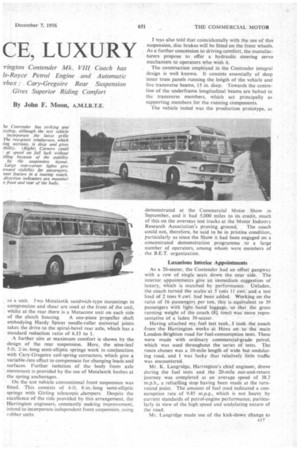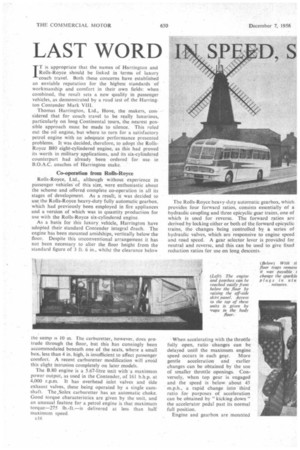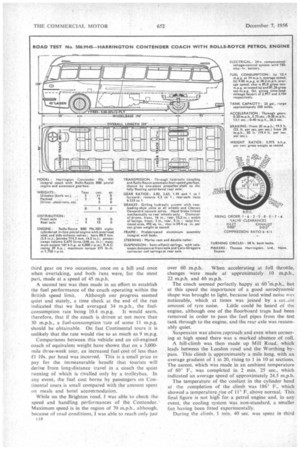CE, LUXURY
Page 63

Page 62

Page 64

Page 67

If you've noticed an error in this article please click here to report it so we can fix it.
• rington Contender Mk. VIII Coack has Is-Royce Petrol Engine and Automatic Tbox : Cary-Gregoire Rear Suspension Gives Superior Riding Comfort
By John F. Moon, A.M.I.R.T.E. IT is appropriate that the names of Harrington and Rolls-Royce should be linked in terms of luxury coach travel. Both these concerns have established an enviable reputation for the highest standards of workmanship and comfort in their own fields: when combined, the result sets a new quality in passenger vehicles, as demonstrated by a road test of the Harrington Contender Mark VIII.
Thomas Harrington, Ltd., Hove, the makers, considered that for coach travel to be really luxurious. particularly on long Continental tours, the nearest possible approach must be made to silence. This ruled out the oil engine, but where to turn for a satisfactory petrol engine with an adequate performance presented problems. It was decided, therefore, to adopt the RollsRoyce B80 eight-cylindered engine, as this had proved its worth in military applications, and its six-cylindered counterpart had already been ordered for use in B.O.A.C. coaches of Harrington make.
Co-operation From Rolls-Royce
Rolls-Royce, Ltd., although without experience in passenger vehicles of this size, were enthusiastic about the scheme and offered complete co-operation in all its stages of development. As a result, it was decided to use the Rolls-Royce heavy-duty fully automatic gearbox. which had previously been employed in fire appliances and a version of which was in quantity production for use with the Rolls-Royce six-cylindered engine.
As a basis for this luxury vehicle, Harrington have adopted their standard Contender integral eoach. The engine has been mounted amidships, vertically below the floor. Despite this unconventional arrangement it has not been necessary to alter the floor height from the standard figure of 3 ft. 6 in., whilst the clearance below
the sump is 10 in. The carburetter, however, does protrude through the floor, but this has cunningly been accommodated beneath one of the seats, where a small box, less than 4 in. high, is insufficient to affect passenger comfort. A recent carburetter modification will avoid this slight intrusion completely on later models.
The B.80 engine is a 5.67-litre unit with-a maximum power output, as used in the Contender, of 161 b.h.p. at 4,000 r.p.m. ft has overhead inlet valves and side exhaust valves, these being operated by a single camshaft. The,Solex carburetter has an automatic choke. Good torque characteristics are given by the unit, and an unusual feature for a petrol engine is that maximum torque-275 lb.-ft.—is delivered at less than half maximum speed.
The Rolls-Royce heavy-duty automatic gearbox, which provides four forward ratios, consists essentially of a hydraulic coupling and three epicyclic gear trains, one of which is used for reverse. The forward ratios arc derived by locking either or both of the forward epicyclic trains, the changes being controlled by a series of hydraulic valves, which are responsive to engine speed and road speed. A gear selector lever is provided for neutral and reverse, and this can be used to give fixed reduction ratios for use on long descents.
When accelerating with the throttle fully open, ratio changes can be delayed until the maximum engine
speed occurs in each gear. More gentle acceleration and earlier changes can be obtained by the use of smaller throttle openings. Conversely, when top gear is engaged and the speed is below about 45 m.p.h., a rapid change into third ratio for purposes of acceleration can be obtained by "kicking down" the accelerator pedal past its normal full position.
Engine and gearbox are mounted as a unit. Iwo Metalastik sandwich-type mountings in compression and shear are used at the front of the unit, whilst at the rear there is a Metacone unit on each side of the clutch housing. A one-piece propeller shaft embodying Hardy Spicer needle-roller universal joints takes the drive to the spiral-bevel rear axle, which has a standard reduction ratio of 6.33 to 1.
A further aim at maximum comfort is shown by the design of the rear suspension. Here, the nine-leaf 5-ft. 2-in.-long semi-elliptic springs work in conjunction with Cary-Gregoire coil-spring correctors, which give a variable-rate effect to compensate for changing loads and surfaces. Further isolation of the body from axle movement is provided by the use of Metalastik bushes at the spring anchorages.
On the test vehicle conventional front suspension was fitted. This consists of 4-ft. 8-in.-long semi-elliptic springs with Girling telescopic 'dampers. Despite the excellence of the ride provided by this arrangement, the Harrington engineers, constantly seeking improvement, intend to incorporate independent front suspension, using rubber units. I was also told that coincidentally with the use of this suspension, disc brakes will be fitted on the front wheels. As a further concession to driving comfort, the manufacturers propose to offer a hydraulic steering Servo mechanism to operators who wish it.
The construction employed in the Contender integral design is well known. It consists essentially of deep inner truss panels running the length of the vehicle and five transverse beams, 15 in. deep. Towards the centreline of the underframe longitudinal beams are bolted to the transyerse members, which act principally as supporting members for the running components.
The vehicle tested was the production prototype, as demonstrated at the Commercial Motor Show in September, and it had 5,000 miles to its credit, much of this on the overseas test tracks at the Motor Industry Research Association's proving ground. The coach could not, therefore, be said to be in pristine condition, particularly as since the Show it had been engaged on a concentrated demonstration programme to a large number of operators, among whom were members of the B.E.T. organization.
Luxurious Interior Appointments As a 26-seater, the Contender had an offset gangway with a row of single seats down the near side. The interior appointments give an immediate suggestion of luxury, which is matched by performance. Unladen, the coach turned the scales at 5 tons 11 cwt. and a test load of 2 tons 9 cwt. had been added. Working on the ratio of 16 passengers per ton, this is equivalent to 39 passengers with lighthand luggage, -so that the gross running weight of the coach (81 tons) was More representative of a laden 39-seater, Having attached my fuel test tank, I took. the coach from the Harrington works it Hove on to • tho main London-Brighton road for fuel-consumption tests. These were made with ordinary commercial-grade petrol. which was used throughout the series of tests. The route chosen was a 10-mile length of wide but undulating road, and I was lucky that relatively little traffic was encountered.
Mr. K. Langridge. Harrington's chief engineer, drove during the fuel tests and the 20-mile out-and-return journey was completed at an average speed of 38.2 m.p.h., a refuelling stop having been made at the turnround point. The amount of fuel used indicated a consumption rate of 9.85 m.p.g., which is not heavy by current standards of petrol-engine performance, particularly in view of the high speed and undulating nature of the road.
Mr. Langridge made use of the kick-down change to F 17
third gear on two occasions, once on a hill and once when overtaking, and both runs were, for the most part, made at a speed of 45 m.p.h.
A second test was then made in an effort to establish the fuel performance of the coach operating within the British speed limit. Although our progress seemed quiet and stately, a time check at the end of the run indicated that we had averaged 34 m.p.h., the fuel
consumption rate being 10.4 m.p.g. It would seem, therefore, that if the coach is driven. at not more than 30 m.p.h., a fuel-consumption -rate of some 11 m.p.g. should be obtainable. On fast Continental tours it is unlikely that the rate would rise to as much as 9 m.p.g.
Comparisons between this vehicle and an oil-engined coach of equivalent weight have shown that on a 3,000mile three-week tour, an increased fuel cost of less than ft 10s. per head was incurred. This is a small price to pay for the immeasurable benefit that tourists will derive from long-distance travel in a coach the quiet running of which is rivalled only by a trolleybus. In any event, the fuel cost borne by passengers on Continental tours is small compared with the amount spent on meals and hotel accommodation.
While on the Brighton road, I was able to check the speed and handling performances of the Contender. ' Maximum speed is in the region of 70 m.p.h.. although. because of road conditions. I was able to reach only just r18 over 60 m.p.h. When accelerating at full throttle,
changes were made at approximately 10 m.p.h., 22 -m.p.h. and 40m.p.h.
The coach seemed perfectly. happy at 60 'm.p.h., but at this speed the importance of a good aerodynamic shape was brought to light, because loud wind noise was noticeable, which at times was joined by a cer.ain
amount of tyre noise. Little could be heard of the engine, although one of the floorboard traps had been removed in order to pass the fuel pipes from the test Lank through to the engine, and the rear axle was reasonably quiet.
Suspension was above reproach and even when cornering at high speed there was a marked absence of roll.
A hill-climb was then made up Mill Road, which leads between the London road and the Worthing bypass. This climb is approximately a mile long, with an average gradient of 1 in 20, rising to 1 in 10 at sections. The ascent, which was made in an ambient temperature of 60° F., was completed in 2 min. 25 sec., which indicated an average speed of approximately 24.5 m.p.h.
The temperature of the coolant in the cylinder head at the completion of the climb was 186° F., which showed a temperature rise of 11° F. above normal. This final figure is not high for a petrol engine and, in any event, the cooling system was non-standard, a smaller fan having been fitted experimentally.
During the climb. 1 min. 40 sec. was spent in third and second ratios. The gearbox was constantly changing between these two gears, which suggested that had an intermediate gear been available this would have suited the torque characteristic of the engine better for this climb. The box fitted to the test vehicle had relatively high gearing, and an alternative set of ratios is to be offered. These will include a low ratio of 4.7 to 1, and a second gear of 3.03 to I.
Mill Road was then descended in top gear at a speed of approximately 20 m.p.h., the descent lasting just over 2+ min. It was impossible to engage neutral for this test, because damage to the gearbox would have resulted, but at this speed there was little retardation effect from the engine.
The brakes had become noticeably warm by the time the bottom of the hill was reached, but an emergency stop from 20 m.p.h. on a wet road produced a Tapley meter reading of 45 per cent., compared with an average figure of 691 per cent. obtained on the following day. with cold drums on a dry road. The pedal pressure during the descent and subsequent emergency stop did not become excessive.
The manufacturers intend fitting larger brakes to future models, with 16-in. by 41-in, front-wheel drums and 15-in. by 6-in, units at the rear. This will give not only a higher anti-fade margin, but will also bring the braking area more into line with that to be expected on an 8-ton vehicle capable of 70 m.p.h. The future use of disc brakes at the front will further enhance braking safety.
Stop-start Test on 1-in-S
A stop-start test on the 1-in-5 gradient of Southover Street, Brighton, was carried out with a fair measure of success, but the test did serve to show that the hill performance of the vehicle will be substantially improved by the use of the alternative gearbox with lower ratios. On this gradient a full-throttle re-start was made, but not without a large measure of transmission slip. During this test the gearbox temperature rose to 120 F., whilst the engine coolant soared to 200° F. The hand brake, which is long enough to provide ample leverage, held the vehicle satisfactorily on this slope.
Brake tests were made along a level stretch of road in a residential area. Excellent stops were made from
20 m.p.h. and 30 m.p.h., and retardation was smooth under emergency conditions..
Although normal braking pressures are fairly high, the emergency pressure is proportionally lighter. This has been brought about by raising the knee point to give light emergency pressures at high .speeds. From 20 m.p.h. several applications of the hand brake produced average Tapley meter readings of 32 per cent., which is a good figure for a fully laden coach.
Acceleration tests were made along the same stretch of road and here the automatic transmission came into its own. The figures obtained would do justice to the average private car, but they are only to be expected with a power-to-weight ratio of almost I b.h.p. per cwt. gross weight, and the extremely quick changes made by the gearbox. In town traffic many private motorists' eyebrows were raised at the way -in which the Contender stormed away from the traffic lights.
Not Tiring to Drive The Contender can in no way said to be tiring to drive, a factwhich will appeal to Continental tour drivers who have to stand up to late nights and long driving hours. The absence of engine noise gives a considerable relief from strain and, of course, the automatic gearbox involves no work at all. The steering is light enough for safety. and driving visibility is of a high standard.
A series of maintenance tests was carried out at the Harrington works. The first consisted of level checks, none of which proved difficult. Ascertaining the water level occupied 7 seconds, whilst the engine and gearbox oil levels were each checked in 6 seconds, to which time must be added 20 seconds for raising the skirt trap and 18 seconds for lowering and securing it. The rear-axle oil level was verified in 48 seconds, this being done frorn underneath the coach.
A small trap in the floor behind the driver's seat gives access to the brake-fluid reservoir. This trap was removed in 22 seconds and the total operation of checking the hydraulic level occupied 65 seconds.
Large Floor Trap for Batteries
The four 6v. batteries are located behind the gearbox and easy access is provided by a large floor trap, the electrolyte 'levels being checked in a, total time of 21 minutes. A trap adjacent to the engine gives access to the air cleaner, and the level of the oil in this unit was ascertained in 21 minutes. Two large floor traps covered the engine, and with these removed it was possible to change the eight sparking plugs in 9 minutes, It was not possible to change the oil-filter element, because no new sealing rings were available, and leaking might have resulted had these rings not been changed.
Adjusting the front-wheel brakes took 2+ minutes, there being two adjusters per wheel, whilst the rear brakes were checked in 41 minutes. the additional time being accounted for by the difficulty of placing the jack below the rear-axle pot. Greasing on the coach has been kept to a minimum, being confined to a total of 13 points on the steering, propeller shaft and pedal shafts.
As a final test, the dynamo driving-belt tension was adjusted in 40 seconds from below the vehicle, which is a cruiek time when a 7-in, dynamo is involved.
The Contender Mark VIII can hold it own against any passenger vehicle made anywhere in the world. The high-speed luxury performance that it provides would suggest a high cost. but this is not the case, as the test v-hicle is priced at £5.000.




























































































































